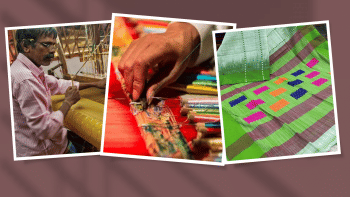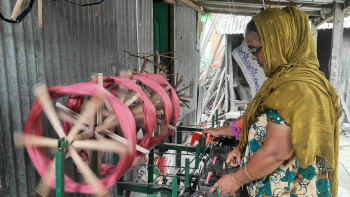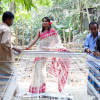The magic of Tangail taant

My first saree was a green one with hot pink borders, or paar, woven in traditional Tangail motifs. I clearly remember it because the green somewhat reminded me of lush paddy fields. It'd been bought from the famous Tangail Saree Kutir on Dhaka's Bailey Road and was a gift from my uncle for plucking out his grey hair; a common chore one ran for the elderly during our childhood, especially in a joint family.
At 14, I did not know that I would eventually end up as the editor of a lifestyle magazine which would, in turn, introduce me to celebrated Tangail saree weavers like the Basaks and legendary personalities like Muneera Emdad of Tangail Saree Kutir.
Of course, India's GI claim that the Tangail saree originated in West Bengal got me thinking. The claim, as ridiculous as it is, has nonetheless been made. A geographical indication (GI) is a country's ownership or claiming of the intellectual property of a particular product. Albeit a little late, the Department of Patents, Designs and Trademarks (DPDT) under the Ministry of Industries has recognised the Tangail saree as a product of Bangladesh after India's claim.
It is for people like Muneera Emdad that this beautiful, lightweight cotton or half-silk saree in butidar, fita paar, and many other designs and vibrant colour contrasts are so popular among women in Bangladesh.
Weavers like Sushil Kumar Basak are iconic and have made significant contributions to making taant sarees fashionable. The Basaks have been involved in the taant handloom trade for generations. In fact, Sushil is a third-generation artisan involved in the trade.
Many years ago, I went to Sushil Basak's house in Tangail where weavers were at work on the loom. Basak had a small gaddi (or showroom) from where he sold the sarees. Later, he renovated and turned the gaddi into a shop.
I remember a conversation I'd had with Sushil Basak at his gaddi—there was a part of the Basak clan who had settled in West Bengal during the 1947 partition and later also during our War of Independence in 1971. They began their trade as weavers and made taant sarees. In fond remembrance of their ancestral home, they named these "Tangail sarees."
The motifs used by the Basaks living in India were predominantly figurines while the designs by the Basaks in Bangladesh are primarily inspired by nature. The diversity in motifs is clearly a result of cultural and religious differences.
To buy West Bengali taant, I once went to a Basak store in Kolkata. The wooden, three-storied store had Indian taant on display, featuring "Tangail motifs." They certainly had a different look from what we are familiar with as being Tangail sarees.
Another memory I have is of my Tangail saree haat experience, a public auction that takes place only twice a week in Bazitpur and Karatia. The auction begins at the crack of dawn. Traders and middlemen come to the bazaars to purchase sarees. While truckloads of the fabric head to Dhaka and other cities, the wholesale auction always has a few customers (like me) who enjoy the fervent bidding and fancy obtaining exclusive sarees, fresh from the looms!
In the early '80s, up till the '90s, Tangail sarees were worn by women at home, work, schools, and banks. Holud festivities meant that saffron Tangail sarees would be worn by the bridesmaids. The celebrated yellow saree, with a vermillion red border, was worn by all and added a beautiful golden aura to the evening programmes. Unfortunately, these beautiful yellow taant have now disappeared from the wedding scene.
There was also a time when ladies used to go to the Basak warehouse and buy sarees in bulk. No doubt, these sarees exude an unavoidable pull, as Tangail taant speaks of romance or riches, of sobriety or gaiety, of sophistication or innocence.
It is said that a saree rarely fails to flatter a woman or make her feel feminine. The quintessential impression created by a cotton saree starched in aap (a silver shimmer used when starching or washing a saree; another practice quite lost today), with beliphool in one's braid is that of a sheer enchantment and one that is Bangalee through and through.
So, here's to losing oneself in the sensuous sorcery of the pure, deshi taant saree and claiming what is truly ours.
Raffat Binte Rashid is features editor at The Daily Star.
Views expressed in this article are the author's own.
Follow The Daily Star Opinion on Facebook for the latest opinions, commentaries and analyses by experts and professionals. To contribute your article or letter to The Daily Star Opinion, see our guidelines for submission.

 For all latest news, follow The Daily Star's Google News channel.
For all latest news, follow The Daily Star's Google News channel. 










Comments